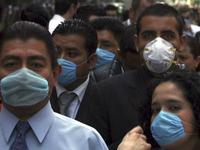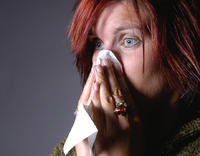-
Radiation fears cripple Japanese food exports

Japanese agricultural exports have yet to recover from the 11 March earthquake and tsunami due largely to fears of radioactive contamination; to combat these fears, local governments have done all they can to assure consumers that their products are safe; consumers remain wary despite these reassurances, and as a result the Japanese agricultural sector is struggling
-
-
How did H1N1 become an pandemic?

The last century has seen two major pandemics caused by the H1N1 virus — the Spanish Flu in 1918 and 2009’s Swine Flu scare, which had thousands travelling with surgical masks and clamoring for vaccination; scientists, however, did not know what distinguished the Swine Flu from ordinary influenza in pigs or seasonal outbreaks in humans, giving it the power to travel extensively and infect large populations; until now
-
-
Software successfully predicted spread of West Nile virus in California
A computer model of the spread of West Nile virus was able to predict areas where human cases would be concentrated, especially around Sacramento in 2005; the success of the model, say researchers, depended on its focus on biological factors and on a high volume of reports from members of the public
-
-
Anthrax exposure prompts FBI investigation
Government health officials are currently investigating a case of anthrax exposure in Minnesota after tests confirmed that an individual hospitalized there had been infected with the dangerous bacteria; due to the deadly nature of anthrax and its use as a biological weapon, the FBI joined Minnesota health officials in investigating the matter
-
-
Medical silver bullet: New drug cures most viral infections

Researchers at MIT’s Lincoln Lab have developed technology that may someday cure the common cold, influenza, and other ailments; the researchers tested their drug against fifteen viruses, and found it was effective against all of them — including rhinoviruses that cause the common cold, H1N1 influenza, a stomach virus, a polio virus, dengue fever, and several other types of hemorrhagic fever
-
-
Reversing metabolism to make biofuels at breakneck pace
Engineers reverse E. coli metabolism for speedy production of fuels, chemicals; a Rice University’s team reversed one of the most efficient of all metabolic pathways — the beta oxidation cycle — to engineer bacteria that produce biofuel at a breakneck pace
-
-
A natural food preservative kills food-borne bacteria
Salmonella and E. coli account for more than half of all food recalls in the United States; salmonella contributes to an estimated 28 percent of more than 3,000 U.S. deaths related to foodborne illness each year; researchers have discovered and received a patent for a naturally occurring lantibiotic — a peptide produced by a harmless bacteria — that could be added to food to kill harmful bacteria like salmonella, E. coli, and listeria
-
-
Innovative biosensor for rapid virus field tests
Relying on a novel DNA-based bio-chemo-physical conversion method, a new bio-detection device is able to detect harmful bacteria, such as E. coli, salmonella, and staphylococcus, on site, within thirty minutes; it can be adapted to cover such deadly viruses as SARS, H5N1 flu, and swine flu viruses; it can also be designed to monitor possible biological attack from anthrax, smallpox, cholera, and more
-
-
Gold nanoparticles help to diagnose flu in minutes
Arriving at a rapid and accurate diagnosis is critical during flu outbreaks, but until now, physicians and public health officials have had to choose between a highly accurate yet time-consuming test or a rapid but error-prone test; University of Georgia researchers offer a solution
-
-
Five Joplin survivors die of mysterious fungal infection
After being hit by a massive tornado that destroyed much of Joplin, Missouri, several residents suffered from a fungal infection that killed five people; following the 22 May twister that ravaged Joplin, many residents suffered from splinters, cuts, and other minor injuries that eventually resulted in a rare fungus infection
-
-
Research inspires robotics design for medicine, military
A pathogen that attacks the small intestines of humans and animals is serving as the inspiration for developing robots that can fight disease and aid in military operations; ror 250 years, scientists have tried to understand how the microorganism is able to attach to a multitude of surfaces and swim in harsh environments — enabling it to infect many kinds of species while most parasites have specific hosts
-
-
Transforming acids into bases
Chemists at the University of California, Riverside have accomplished in the lab what until now was considered impossible: transform a family of compounds which are acids into bases; the research offers vast family of new catalysts for use in drug discovery, biotechnology
-
-
Anthrax vaccine program demonstrates 36 month product stability
Maryland-based PharmAthene has achieved an important program milestone in its recombinant protective antigen (rPA) anthrax vaccine program, and demonstrated thirty-six month stability of its rPA drug product candidate; the data suggest that the rPA product candidate is both highly stable and potent; stability has historically been a stumbling block for other recombinant anthrax vaccine programs
-
-
Melting ice sheets release toxic pollutants outlawed in 2001
The melting of arctic ice sheets causes the rise in sea levels — but there is another danger: the melting causes dangerous chemicals, including the notoriously toxic DDT, to be freed from Arctic sea ice and snow; the chemical — known as “persistent organic pollutants” (POPs) — were widely used as insecticides and pesticides before being outlawed in 2001; they are extremely tough molecules that take decades to break down in nature; they also bio-accumulate, meaning that as they pass up the food chain, concentrations rise, posing a fertility threat to higher species
-
-
New way to attack Salmonella bacteria found
Nitric oxide is naturally produced in the nose and the gut and other tissues in the body to ward off infection; new research underscores that nitric oxide’s antimicrobial actions are due to its interference with the metabolism, or energy production, of pathogens —p and that these antimicrobial characteristics may be harnessed to inhibit the growth of Salmonella
-
More headlines
The long view
We Ran the C.D.C.: Kennedy Is Endangering Every American’s Health
Nine former leaders of the Centers for Disease Control and Prevention (CDC), who served as directors or acting directors under Republican and Democratic administrations, serving under presidents from Jimmy Carter to Donald Trrump, argue that HHS Secretary Roert F. Kennedy Jr. poses a clear and present danger to the health of Americans. He has placed anti-vaxxers and conspiracy theorists at top HHS positions, and he appears to be guided by a hostility to science and a belief in bizarre, unscientific approaches to public health.
